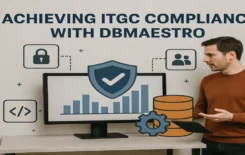A database compliance audit can be a veritable nightmare. No one loves an audit and no one wants to be in the hot seat. But database compliance is a major issue that continues to be one of the topmost priorities for IT organizations, and there is no end in sight.
Hopefully you won’t face an audit. But if and when you do, you had better be able to account for your data – including what changes were made to the database, when, by whom, and for what reason.
Given the fact that SCM (Software Configuration Management) solutions do not track or provide audit trails for database changes, this can be a real problem. Just where will the needed details come from? A database compliance audit is not the time when you want to rely completely on memory to explain database changes.
The solution? A premier database management solution.
How a Sophisticated Management Solution Secures Database Compliance
Consider DBmaestro’s own TeamWork database management solution for example. TeamWork enables IT organizations to meet their compliance requirements for their databases, including COBIT (Control Objectives for Information and related Technology) and GLBA (Gramm-Leach-Bliley Act) compliance requirements.
Does the auditor want to know what changes were made to the database? A duly sophisticated database management solution will save and track all database change versions.
Does the auditor want to know the reason for the change and/or who made the changes? Best in class DB management solutions integrate with major SCM products, such as IBM Rational Team Concert and Microsoft Team Foundation Server.
Through this integration, changes to an application’s database can be linked to a work item or change set, which identify the reason for the change and the person responsible.
Navigating the Audit Trail for Database Compliance
A premier database management solution such as DBmaestro’s TeamWork will provide you with access to a reliable audit trail for the managed database object definitions as well as the ability to manage content. In fact, by using proven change management methodologies at the database level, the right solution will become an integral part of your development process.
It enforces compliance with change policy through all stages of the development process, from development through testing to production:
- Changes to database objects must be documented and approved
- The audit trail of object changes must be reviewed
- Database changes made in development must be deployed to testing and production
So before you face a compliance audit, look for the right database management solution for your business. Then, relax and breeze through the audit.






